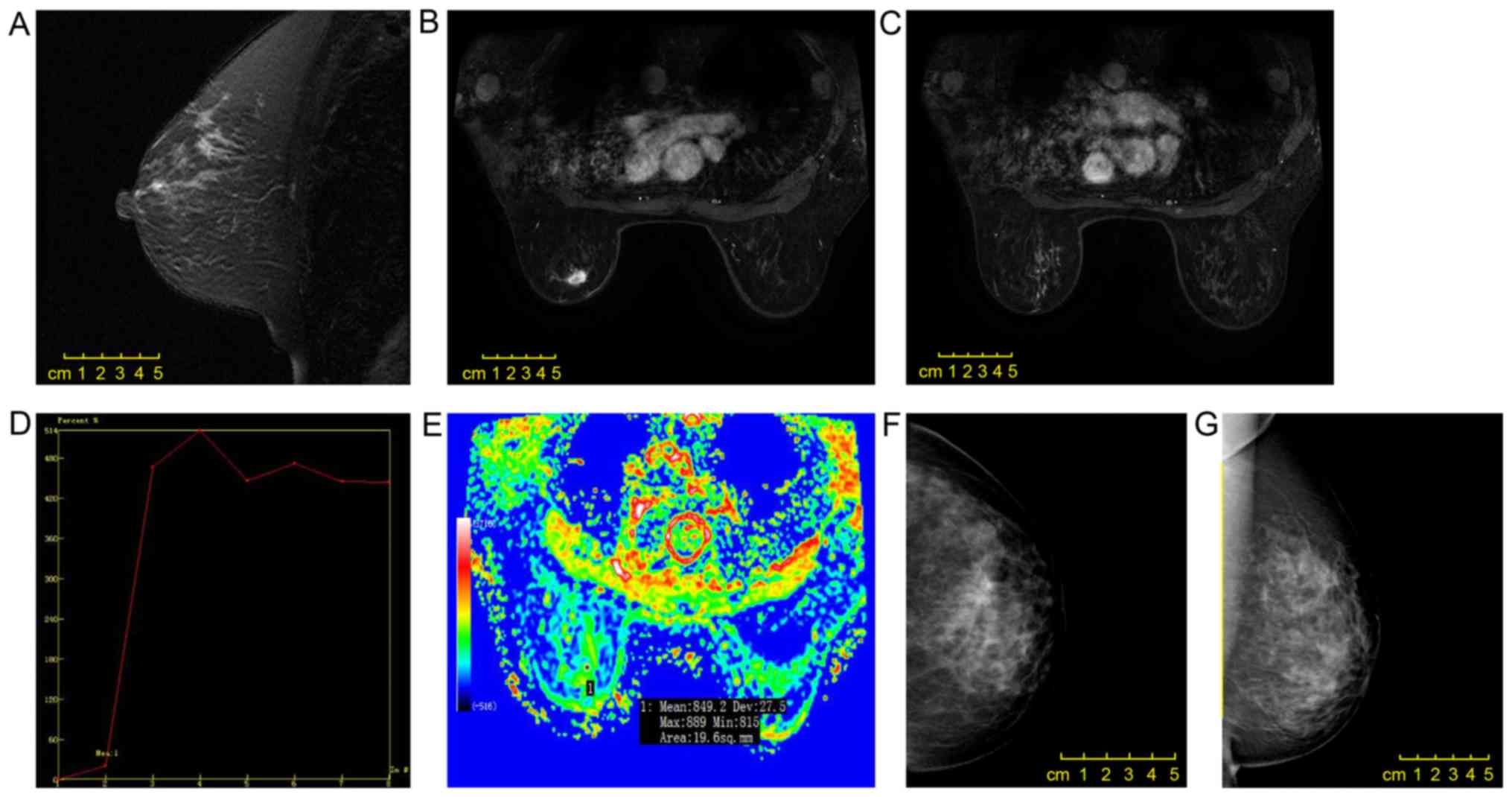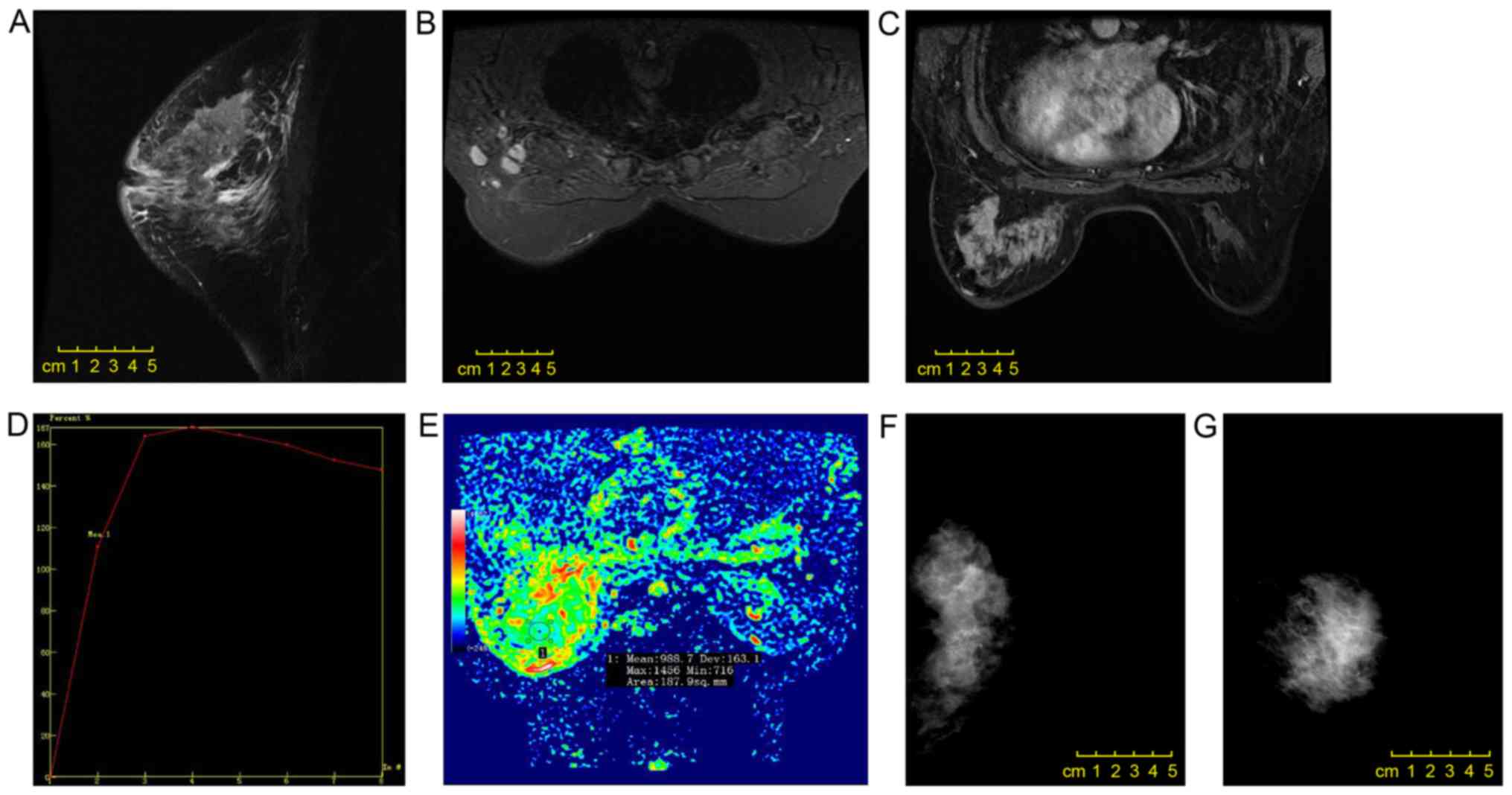|
1
|
Tavassoli FA and Devilee P: Pathology and
genetics of tumors of the breast and female genital organs. World
Health Organization classification of tumors. IARC Press. 2003.
|
|
2
|
Siriaunkgul S and Tavassoli FA: Invasive
micropapillary carcinoma of the breast. Mod Pathol. 6:660–662.
1993.PubMed/NCBI
|
|
3
|
Luna-More S, Gonzalez B, Acedo C, Rodrigo
I and Luna C: Invasive micropapillary carcinoma of the breast. A
new special type of invasive mammary carcinoma. Pathol Res Pract.
190:668–674. 1994. View Article : Google Scholar : PubMed/NCBI
|
|
4
|
Zekioglu O, Erhan Y, Ciris M, Bayramoglu H
and Ozdemir N: Invasive micropapillary carcinoma of the breast:
High incidence of lymph node metastasis with extranodal extension
and its immunohistochemical profile compared with invasive ductal
carcinoma. Histopathology. 44:18–23. 2004. View Article : Google Scholar : PubMed/NCBI
|
|
5
|
Lewis GD, Xing Y, Haque W, Patel T,
Schwartz M, Chen A, Farach A, Hatch S, Butler EB, Chang J and Teh
BS: Prognosis of lymphotropic invasive micropapillary breast
carcinoma analyzed by using data from the national cancer database.
Cancer Commun (Lond). 39:602019. View Article : Google Scholar : PubMed/NCBI
|
|
6
|
Li W, Han Y, Wang C, Guo X, Shen B, Liu F,
Jiang C, Li Y, Yang Y, Lang R, et al: Precise pathologic diagnosis
and individualized treatment improve the outcomes of invasive
micropapillary carcinoma of the breast: A 12-year prospective
clinical study. Mod Pathol. 31:956–964. 2018. View Article : Google Scholar : PubMed/NCBI
|
|
7
|
Kaya C, Uçak R, Bozkurt E, Ömeroğlu S,
Kartal K, Yazıcı P, Idiz UO and Mihmanli M: The impact of
micropapillary component ratio on the prognosis of patients with
invasive micropapillary breast carcinoma. J Invest Surg. 1–9.
2018.
|
|
8
|
Kamitani K, Kamitani T, Ono M, Toyoshima S
and Mitsuyama S: Ultrasonographic findings of invasive
micropapillary carcinoma of the breast: Correlation between
internal echogenicity and histological findings. Breast Cancer.
19:349–352. 2012. View Article : Google Scholar : PubMed/NCBI
|
|
9
|
Mizushima Y, Yamaguchi R, Yokoyama T, Ogo
E and Nakashima O: Recurrence of invasive micropapillary carcinoma
of the breast with different ultrasound features according to
lesion site: Case report. Kurume Med J. 58:81–85. 2011. View Article : Google Scholar : PubMed/NCBI
|
|
10
|
Adrada B, Arribas E, Gilcrease M and Yang
WT: Invasive micropapillary carcinoma of the breast: Mammographic,
sonographic, and MRI features. AJR Am J Roentgenol. 193:W58–W63.
2009. View Article : Google Scholar : PubMed/NCBI
|
|
11
|
Yun SU, Choi BB, Shu KS, Kim SM, Seo YD,
Lee JS and Chang ES: Imaging findings of invasive micropapillary
carcinoma of the breast. J Breast Cancer. 15:57–64. 2012.
View Article : Google Scholar : PubMed/NCBI
|
|
12
|
Alsharif S, Daghistani R, Kamberoğlu EA,
Omeroglu A, Meterissian S and Mesurolle B: Mammographic,
sonographic and MR imaging features of invasive micropapillary
breast cancer. Eur J Radiol. 83:1375–1380. 2014. View Article : Google Scholar : PubMed/NCBI
|
|
13
|
Lim HS, Kuzmiak CM, Jeong SI, Choi YR, Kim
JW, Lee JS and Park MH: Invasive micropapillary carcinoma of the
breast: MR imaging findings. Korean J Radiol. 14:551–558. 2013.
View Article : Google Scholar : PubMed/NCBI
|
|
14
|
Jones KN, Guimaraes LS, Reynolds CA, Ghosh
K, Degnim AC and Glazebrook KN: Invasive micropapillary carcinoma
of the breast: Imaging features with clinical and pathologic
correlation. AJR Am J Roentgenol. 200:689–695. 2013. View Article : Google Scholar : PubMed/NCBI
|
|
15
|
Kubota K, Ogawa Y, Nishioka A, Murata Y,
Itoh S, Hamada N, Morio K, Maeda H and Tanaka Y: Radiological
imaging features of invasive micropapillary carcinoma of the breast
and axillary lymph nodes. Oncol Rep. 20:1143–1147. 2008.PubMed/NCBI
|
|
16
|
Peng YX, Cai HM and CY C: Vulation the
differential value of diffusion-weighted imaging and dynamic
contrast-enhanced magnetic resonance in breast lesions. Chinese
Journal. 11:1–4. 2014.
|
|
17
|
Günhan-Bilgen I, Zekioglu O, Ustün EE,
Memis A and Erhan Y: Invasive micropapillary carcinoma of the
breast: Clinical, mammographic, and sonographic findings with
histopathologic correlation. AJR Am J Roentgenol. 179:927–931.
2002. View Article : Google Scholar : PubMed/NCBI
|
|
18
|
Allarakha A, Gao Y, Jiang H and Wang PJ:
Prediction and prognosis of biologically aggressive breast cancers
by the combination of DWI/DCE-MRI and immunohistochemical tumor
markers. Discov Med. 27:7–15. 2019.PubMed/NCBI
|
|
19
|
American College of Radiology, Breast
Imaging Reporting and Data System (BI-RADS). (4th). American
College of Radiology. (Reston). 563–570. 2013.
|
|
20
|
Onder S, Fayda M, Karanlık H, Bayram A,
Şen F, Cabioglu N, Tuzlalı S, İlhan R and Yavuz E: Loss of ARID1A
expression is associated with poor prognosis in invasive
micropapillary carcinomas of the breast: A clinicopathologic and
immunohistochemical study with long-term survival analysis. Breast
J. 23:638–646. 2017. View Article : Google Scholar : PubMed/NCBI
|
|
21
|
Shi WB, Yang LJ, Hu X, Zhou J, Zhang Q and
Shao ZM: Clinico-pathological features and prognosis of invasive
micropapillary carcinoma compared to invasive ductal carcinoma: A
population-based study from China. PLoS One. 9:e1013902014.
View Article : Google Scholar : PubMed/NCBI
|
|
22
|
Gokce H, Durak MG, Akin MM, Canda Y, Balci
P, Ellidokuz H, Demirkan B, Gorken IB, Sevinc AI, Kocdor MA, et al:
Invasive micropapillary carcinoma of the breast: A
clinicopathologic study of 103 cases of an unusual and highly
aggressive variant of breast carcinoma. Breast J. 19:374–381. 2013.
View Article : Google Scholar : PubMed/NCBI
|
|
23
|
Hashmi AA, Aijaz S, Mahboob R, Khan SM,
Irfan M, Iftikhar N, Nisar M, Siddiqui M, Edhi MM, Faridi N and
Khan A: Clinicopathologic features of invasive metaplastic and
micropapillary breast carcinoma: Comparison with invasive ductal
carcinoma of breast. BMC Res Notes. 11:5312018. View Article : Google Scholar : PubMed/NCBI
|
|
24
|
Kim MJ, Gong G, Joo HJ, Ahn SH and Ro JY:
Immunohistochemical and clinicopathologic characteristics of
invasive ductal carcinoma of breast with micropapillary carcinoma
component. Arch Pathol Lab Med. 129:1277–1282. 2005.PubMed/NCBI
|
|
25
|
Ross JS, Fletcher JA, Linette GP, Stec J,
Clark E, Ayers M, Symmans WF, Pusztai L and Bloom KJ: The her-2/neu
gene and protein in breast cancer 2003: Biomarker and target of
therapy. Oncologist. 8:307–325. 2003. View Article : Google Scholar : PubMed/NCBI
|
|
26
|
Kuroda H, Sakamoto G, Ohnisi K and Itoyama
S: Clinical and pathologic features of invasive micropapillary
carcinoma. Breast Cancer. 11:169–174. 2004. View Article : Google Scholar : PubMed/NCBI
|
|
27
|
Nassar H, Wallis T, Andea A, Dey J, Adsay
V and Visscher D: Clinicopathologic analysis of invasive
micropapillary differentiation in breast carcinoma. Mod Pathol.
14:836–841. 2001. View Article : Google Scholar : PubMed/NCBI
|
|
28
|
Guo X, Chen L, Lang R, Fan Y, Zhang X and
Fu L: Invasive micropapillary carcinoma of the breast: Association
of pathologic features with lymph node metastasis. Am J Clin
Pathol. 126:740–746. 2006. View Article : Google Scholar : PubMed/NCBI
|
|
29
|
Evans A, Pinder S, Wilson R, Sibbering M,
Poller D, Elston C and Ellis I: Ductal carcinoma in situ of the
breast: Correlation between mammographic and pathologic findings.
AJR Am J Roentgenol. 162:1307–1311. 1994. View Article : Google Scholar : PubMed/NCBI
|
|
30
|
Ferretti G, Felici A, Papaldo P, Fabi A
and Cognetti F: HER2/neu role in breast cancer: From a prognostic
foe to a predictive friend. Curr Opin Obstet Gynecol. 19:56–62.
2007. View Article : Google Scholar : PubMed/NCBI
|
















